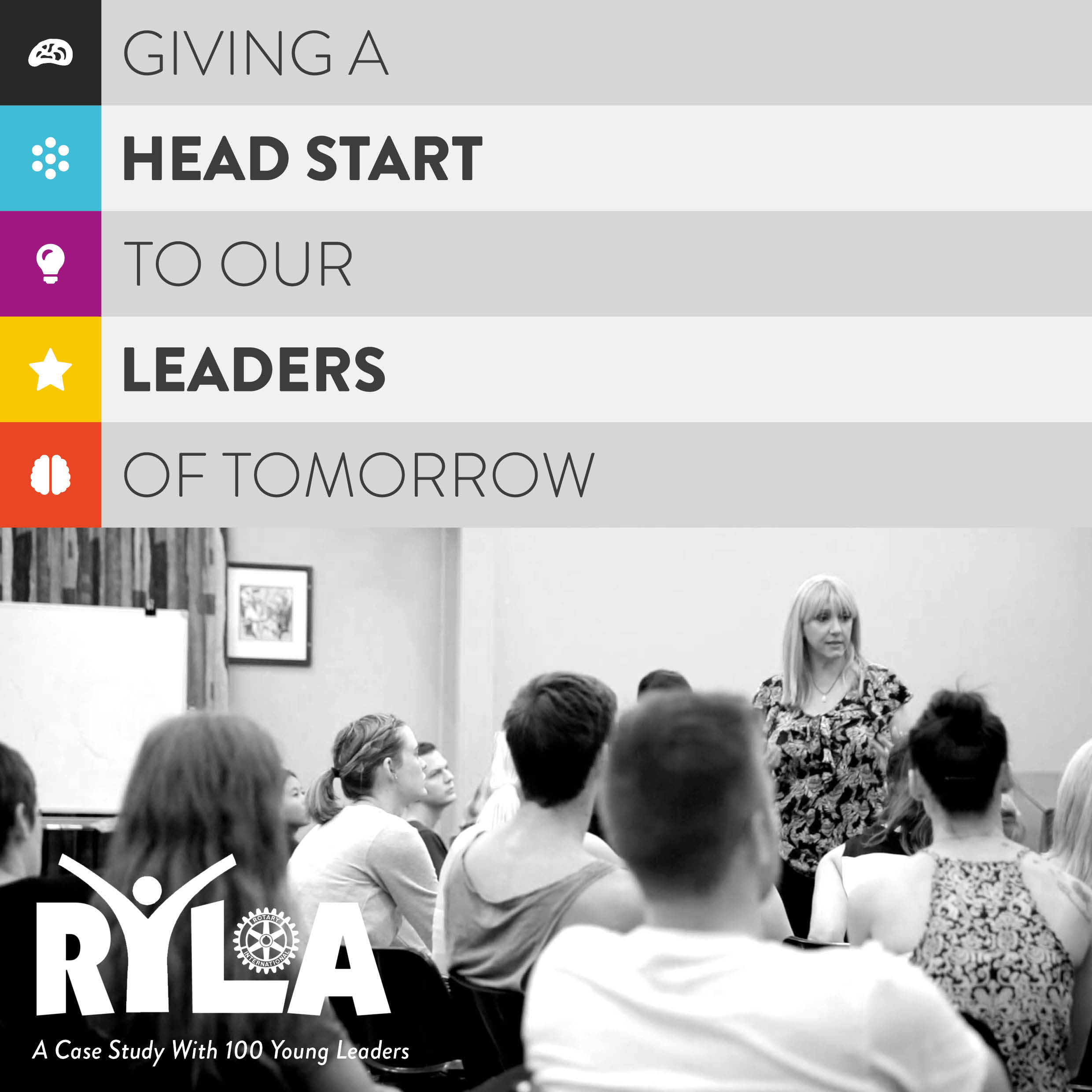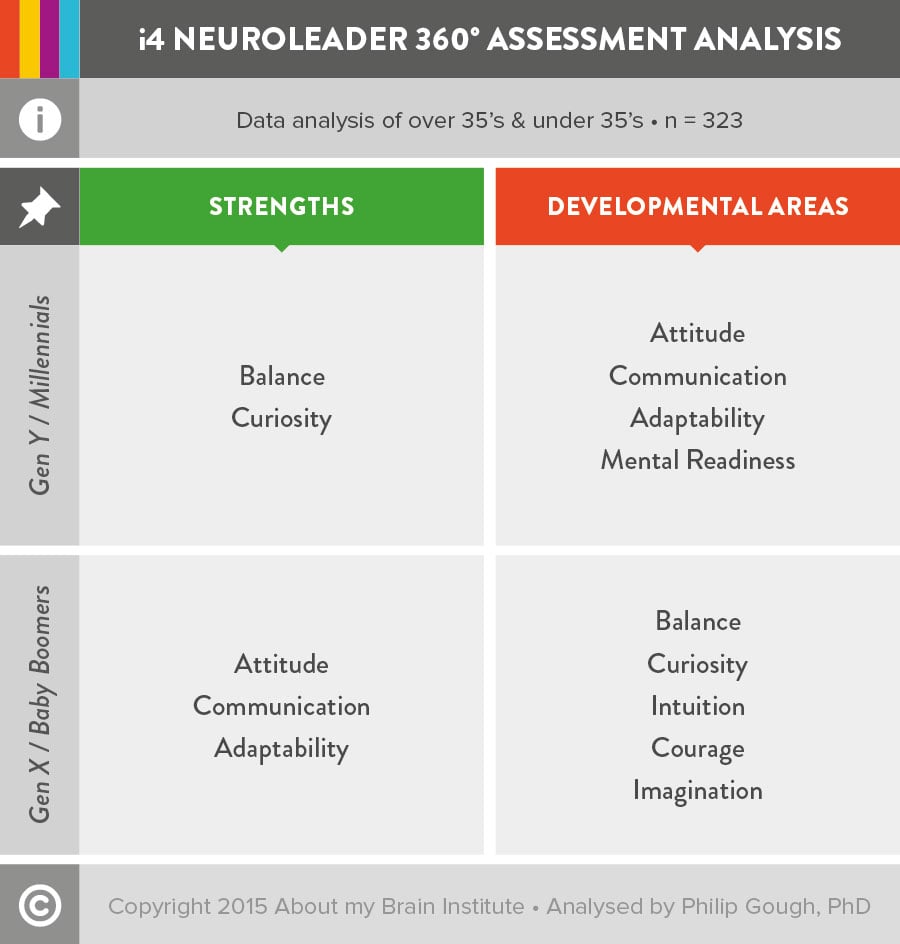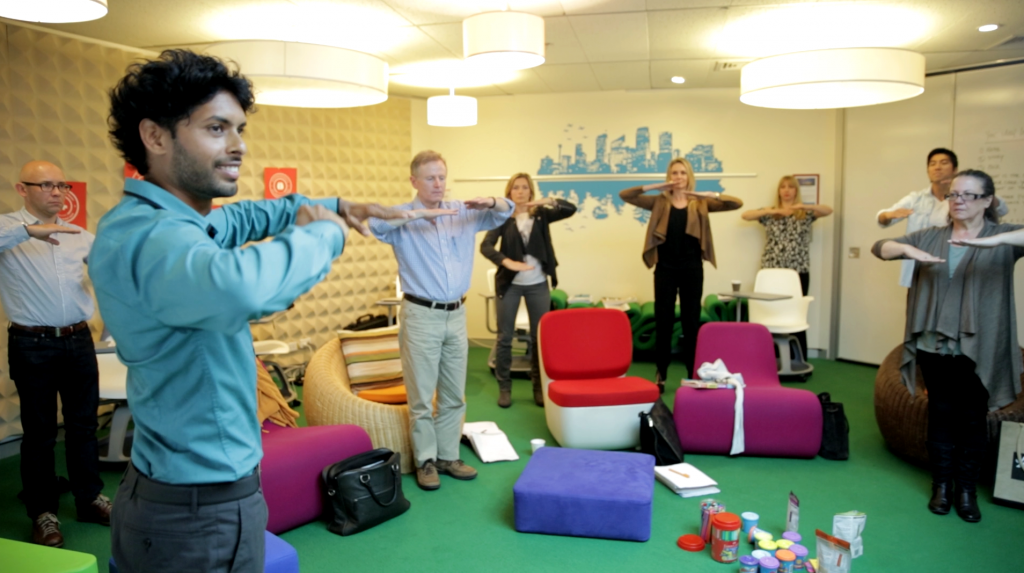Giving A Head Start To Our Leaders Of Tomorrow
An application of the i4 Neuroleader Model & 360 Assessment. A program created by Silvia Damiano from the About my Brain Institute in conjunction with RYLA.

The Rotary Youth Leadership Awards (RYLA) is a recognition program for high-potential 18 to 26-year olds, selected by Rotary based on their significant leadership potential.
They and others like them are the individuals who, in 15 or 20 years, will be heading up our largest companies, be influential voices with the ability to shape public opinion, and be elected and thereby entrusted to manage the affairs of our country.
These future leaders, or ‘RYLArians,’ participated in a challenging week-long residential retreat-- one designed to foster new ideas, share opinions, promote self-discovery, create enduring friendships, and build stronger ties to the community.
The Imperative To Participate
Over the last few decades, leadership/management development programs were often the privilege of a select few, offered to assist people in organisations to improve the skills thought to be necessary in order to be an effective leader of others.
These programs were typically offered only after individuals found themselves in leadership roles—with development on a parallel track with the existing demands of leading a team.
The demands of today’s innovation-era economy and the growing number of GenY/Millennial workers are actually creating a unique opportunity.
As the primary skill-set for leaders shifts to support abilities that inspire, motivate, and engage others, and GenY/Millennial voices call out for developmental opportunities that help both organization and individual to succeed and grow, personal leadership models are emerging, like the  by example, that apply to any individual, at any level, and of any age, gender, or race because they are also, at their core, individual effectiveness models.
by example, that apply to any individual, at any level, and of any age, gender, or race because they are also, at their core, individual effectiveness models.
Because the skills of the i4 Model transcend level, role, and occupation—they can be taught and have application and benefit for anyone—including those individuals who have yet to lead a team, but demonstrate the tremendous potential displayed by individuals like our “RYLArians.”
The changing landscape of today’s workplace has afforded us an opportunity to prepare our future leaders for the demands that will be facing them years from now. Imagine the very tantalizing prospect of new leaders, stepping fully and confidently into leadership roles, and using skills they have been developing since the very start of their careers.
This was our reason, our imperative, to be a part of this seminal development program for these already outstanding future leaders. With the Rotary as our enthusiastic partner and sponsor, we offered each of the participants the chance to learn more about themselves, to experience the power of feedback, and to learn about effective leadership.
Their learning journey included workshops and the completion of the  as a way to introduce the importance of receiving feedback and the need to practice self-reflection as two of the key pillars in the development of leadership.
as a way to introduce the importance of receiving feedback and the need to practice self-reflection as two of the key pillars in the development of leadership.
Video Case Study – Awareness Into Action
The video case study contains actual footage shot during the retreat on the day when all 100 participants received their i4 Neuroleader 360 reports.
It also contains interviews conducted with both the participants and their Rotary sponsors. For many, this was their first exposure to receiving feedback through the use of a 360 assessment tool. The enthusiasm, curiosity, and natural courage displayed by the participants was congruent with trends extracted from their group data, which are highlighted in the insights section that follows.
Analyzing The Data – Insights Gained From The Project
With 100 participants (all within the same GenY/Millennial generational age group) taking the i4 Neuroleader 360 assessment at the same time, a unique opportunity emerged to analyze the group data and compare those results to trend data within our larger global database.
What might the data confirm in terms of what we know, or intuitively know about this emerging and fast growing segment of our global workforce? What surprises might the data reveal? And most importantly, what could the data tell us to better understand, connect with, and address the current needs of tomorrow’s future leaders?
The data told us quite a lot.
Based on the analysis of the RYLArian group data, the i4 pillars with the greatest average scores across their rater data were curiosity and balance. The most significant areas for improvement for this group were in the pillars of mental readiness, adaptability, communication and attitude.
Compare this result to our more ‘mature in years’ global database sample (the ‘over-35s’), where the pillars of greatest strength were adaptability, attitude, and communication—almost the exact pillars that are areas of developmental need for our high-potential future leaders (the ‘under-35s). And the top areas of developmental need for the ‘over-35s’ group—Intuition, Balance, Courage, Imagination, and Curiosity.

So, what happens to individuals as they move from the wide-eyed, enthusiastic and courageous youths in our ‘under-35’ sample to the more ‘seasoned’ business people who populate our normative sample?
As most individuals over the age of 35 might intuit, the innate i4 Neuroleader model strengths of balance and curiosity—found in abundant supply in our RYLArian group data, dissipate over the next 10 to 15 years-so much so, that pillars of innate strength for under-25s become areas of developmental need (on average) about the time when these individuals are leading teams, departments, divisions, and in some cases, entire organizations.
What happens, over that 10 to 15 year-period, that drains away the strengths of balance and curiosity? While it could be interesting to speculate, even assign blame for this erosion of strengths, it is probably more useful to speculate on what might be possible if individuals never lost these strengths in the first place.
If at age 35, or 40, or 50, the average leader were both naturally balanced and curious. How might the average workplace, your own workplace by example, be affected by leaders who were both supportive of and encouraging their teams to exercise, eat well, take regular breaks from work, and daydream?
Who regularly sought out feedback and acted upon it, stayed current on new thinking, research, and technology, and sought to change the status quo when there was the potential to improve productivity through new efficiencies and through lifting employee engagement by reinforcing the need for and value of balance in the workplace?
And what about the ‘under-35’ groups areas of developmental need—in the pillars of attitude, communication, adaptability, and mental readiness? The same trend analysis suggests the development of the pillars of attitude, communication, and adaptability naturally occur with experience and age—becoming strengths later in life.
Again, what are the possibilities, if we accelerate these critical leadership pillars through development at the start of an individual’s career, while simultaneously nurturing their existing strengths of balance and curiosity?
Here is another tantalizing thought—a high-performing individual contributor, technically strong, who is promoted to lead a team for the first time, say at the age of 28, who embodies the behaviors of balance, is naturally curious, is a great communicator with a positive, ‘anything is possible’ attitude, and comfortable with ambiguity and the ever changing landscape of business?
One possible outcome from the described scenario is the heads of Human Resources across the nation, and particularly in the tech sector capital of Silicon Valley who face this emerging leader ‘skill vacuum’ every day, simultaneously letting out a giant squeal of both delight and relief, bested only by the same sound made by the individuals who end up reporting to these new leaders.
Delighted squeals aside, the real possibility that emerges is the transformation of new leaders and the workplaces they lead. And it is more than possible. It is infinitely achievable if businesses simply changed the lens through which they view leadership success and start developing emerging leaders using a personal leadership model that will equip them for success when that first and critically important promotion to a ‘leader of people’ occurs.
CONCLUSION
We believe that the heads of Human Resources department across the country and around the world would agree that leadership skills are as important as technical ability when considering who to promote into a team leader role—a defining moment in any individual’s leadership journey.
It is likely they would also agree that too often, leadership skills become secondary to technical ability when promoting an individual into a team leader position, mainly because those skills are not developed--are not an organizational priority--until a leader is already in the ‘hot seat.’ When leaders are already leading.
The emergence of personal leadership models like the i4 Neuroleader Model are providing organizations with a unique opportunity to address this widespread phenomenon—of new leaders being thrown into the proverbial ‘deep end of the pool’--forced to lead while learning to lead at the same time--and with a fair number of them sinking rather than swimming.
One solution—embrace new thinking and new models of leadership for the new workplace demands of today’s global innovation economy. Nurture your employees’ innate strengths from the start of their careers while accelerating development of strengths that normally take years, decades in some cases, to emerge.
Finally, create a culture where feedback is truly viewed as a gift. One that is received with the enthusiasm, curiosity, and courage demonstrated by our RYLAian leaders of tomorrow.
- i4 Neuroleader (353)
- Leadership & Culture (336)
- Brain Health & Wellbeing (206)
- Innovation (97)
- Performance (85)
- Our News (79)
- Collaboration (68)
- Agility (53)
- Practitioner Stories (44)
- In The Press (36)
- Make Me A Leader (33)
- Balance (31)
- Integration (30)
- Imagination (29)
- Awareness (23)
- Brain-Friendly Channel (22)
- Brain-Friendly Leadership (22)
- Communication (22)
- Curiosity (21)
- Inspiration (19)
- Intuition (19)
- Attitude (17)
- Courage (16)
- Adaptability (14)
- Case Studies (14)
- Drive (14)
- Generosity (13)
- Ethics (9)
- Mental Readiness (9)
- Influence (8)
- Retreat (8)
- Brain-Friendly Leadership (1)
- Oracle Cards (1)
- 1 November 2025 (2)
- 1 September 2025 (3)
- 1 August 2025 (5)
- 1 July 2025 (5)
- 1 June 2025 (2)
- 1 April 2025 (1)
- 1 March 2025 (8)
- 1 February 2025 (3)
- 1 September 2024 (4)
- 1 July 2024 (2)
- 1 June 2024 (6)
- 1 May 2024 (2)
- 1 April 2024 (3)
- 1 March 2024 (1)
- 1 November 2023 (1)
- 1 August 2023 (1)
- 1 July 2023 (2)
- 1 June 2023 (2)
- 1 May 2023 (4)
- 1 April 2023 (2)
- 1 March 2023 (7)
- 1 February 2023 (4)
- 1 January 2023 (1)
- 1 September 2022 (1)
- 1 May 2022 (3)
- 1 April 2022 (1)
- 1 March 2022 (5)
- 1 February 2022 (4)
- 1 January 2022 (4)
- 1 December 2021 (2)
- 1 November 2021 (4)
- 1 October 2021 (3)
- 1 September 2021 (6)
- 1 August 2021 (1)
- 1 April 2021 (1)
- 1 December 2020 (2)
- 1 November 2020 (1)
- 1 September 2020 (1)
- 1 August 2020 (1)
- 1 July 2020 (3)
- 1 June 2020 (4)
- 1 May 2020 (3)
- 1 April 2020 (4)
- 1 March 2020 (6)
- 1 February 2020 (4)
- 1 January 2020 (2)
- 1 December 2019 (3)
- 1 November 2019 (3)
- 1 October 2019 (5)
- 1 September 2019 (4)
- 1 August 2019 (4)
- 1 July 2019 (4)
- 1 June 2019 (5)
- 1 May 2019 (9)
- 1 April 2019 (9)
- 1 March 2019 (8)
- 1 February 2019 (7)
- 1 January 2019 (8)
- 1 December 2018 (5)
- 1 November 2018 (10)
- 1 October 2018 (16)
- 1 September 2018 (9)
- 1 August 2018 (10)
- 1 July 2018 (9)
- 1 June 2018 (8)
- 1 May 2018 (9)
- 1 April 2018 (9)
- 1 March 2018 (9)
- 1 February 2018 (8)
- 1 January 2018 (8)
- 1 December 2017 (6)
- 1 November 2017 (9)
- 1 October 2017 (9)
- 1 September 2017 (8)
- 1 August 2017 (10)
- 1 July 2017 (8)
- 1 June 2017 (8)
- 1 May 2017 (9)
- 1 April 2017 (8)
- 1 March 2017 (6)
- 1 January 2017 (3)
- 1 December 2016 (4)
- 1 November 2016 (5)
- 1 October 2016 (4)
- 1 September 2016 (2)
- 1 August 2016 (4)
- 1 July 2016 (4)
- 1 June 2016 (2)
- 1 May 2016 (3)
- 1 April 2016 (3)
- 1 March 2016 (7)
- 1 February 2016 (2)
- 1 January 2016 (5)
- 1 December 2015 (2)
- 1 November 2015 (2)
- 1 October 2015 (4)
- 1 September 2015 (2)
- 1 August 2015 (2)
- 1 July 2015 (1)
- 1 June 2015 (3)
- 1 May 2015 (4)
- 1 April 2015 (5)
- 1 March 2015 (3)
- 1 February 2015 (3)
- 1 January 2015 (3)
- 1 December 2014 (3)
- 1 November 2014 (3)
- 1 October 2014 (3)
- 1 September 2014 (5)
- 1 August 2014 (4)
- 1 July 2014 (5)
- 1 June 2014 (3)
- 1 May 2014 (1)
- 1 March 2014 (1)
- 1 December 2013 (2)
- 1 November 2013 (1)
- 1 July 2013 (1)
- 1 June 2013 (1)
- 1 May 2013 (3)
- 1 April 2013 (1)
- 1 March 2013 (2)
- 1 February 2013 (1)
- 1 January 2013 (2)
- 1 November 2012 (1)
- 1 October 2012 (1)
- 1 September 2012 (1)
- 1 August 2012 (2)
- 1 July 2012 (1)
- 1 June 2012 (1)
- 1 May 2012 (2)
- 1 April 2012 (1)
- 1 February 2012 (1)
- 1 January 2012 (1)
- 1 November 2011 (1)
- 1 October 2011 (3)
- 1 September 2011 (2)
- 1 July 2011 (1)
- 1 June 2011 (1)
- 1 May 2011 (1)
- 1 April 2011 (1)
- 1 March 2011 (1)
- 1 February 2011 (2)
- 1 January 2011 (4)
- 1 December 2010 (4)
- 1 November 2010 (3)
- 1 October 2010 (5)
- 1 September 2010 (4)
- 1 August 2010 (4)
- 1 July 2010 (3)
- 1 June 2010 (4)
- 1 May 2010 (7)
- 1 April 2010 (5)
Subscribe by email
You May Also Like
These Related Stories

Bring Balance Back to Your Life with the i4 Neuroleader Model

Creating a Brain Friendly Culture At Ultraceuticals



No Comments Yet
Let us know what you think